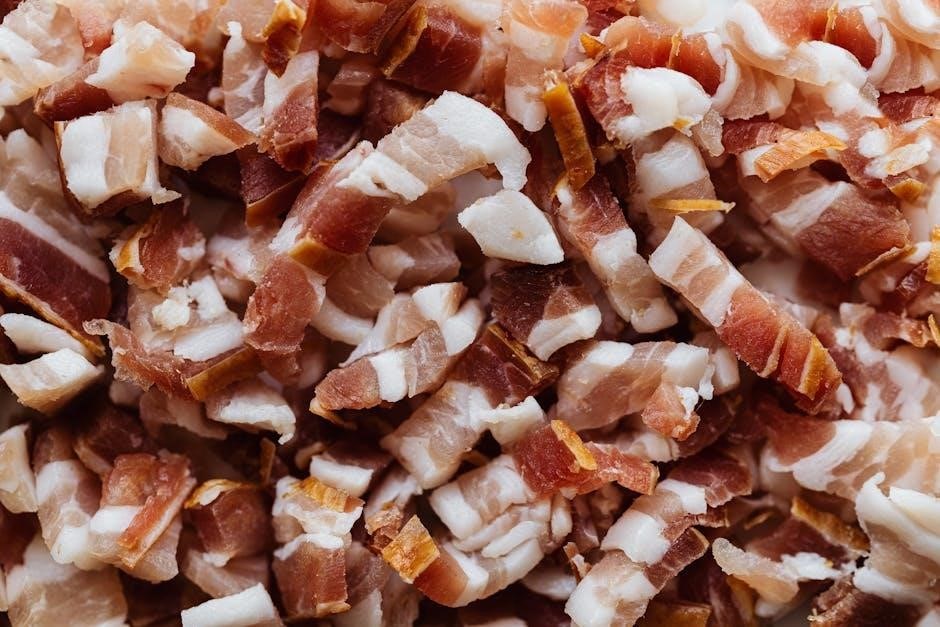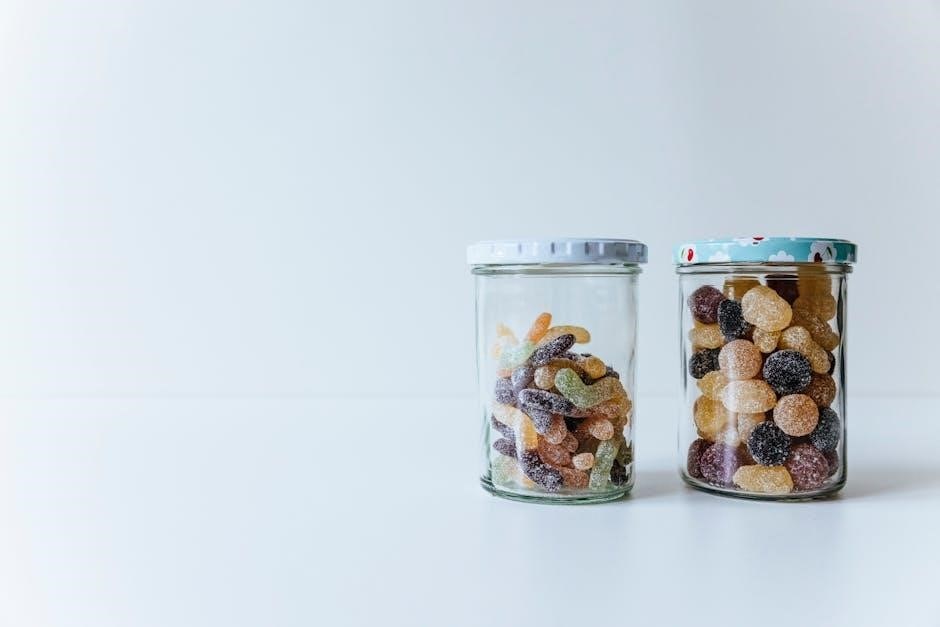
low fat food list pdf
Low-fat foods are essential for a healthy diet, supporting weight management and heart health. They include fruits, vegetables, lean proteins, and whole grains, guiding balanced nutrition and meal planning effectively.
Overview of Low-Fat Diets
A low-fat diet focuses on reducing overall fat intake, particularly saturated and trans fats, to promote better health outcomes. It emphasizes whole, nutrient-rich foods like fruits, vegetables, lean proteins, and whole grains. This dietary approach is often recommended for weight management, heart health, and improving digestion. By limiting high-fat foods such as processed snacks, fried items, and fatty meats, individuals can lower their risk of chronic diseases. Additionally, low-fat diets are beneficial for those with specific health conditions, such as gallbladder issues or pancreatic insufficiency, where fat digestion is challenging. The goal is to create a balanced and sustainable eating pattern that supports long-term well-being while maintaining flavor and satisfaction in meals.
Importance of a Low-Fat Food List
A low-fat food list is a crucial tool for individuals aiming to adopt a healthier diet. It helps identify which foods are naturally low in fat, making meal planning easier and more efficient. By focusing on these options, individuals can reduce their intake of harmful saturated and trans fats, which are linked to heart disease and weight gain. A well-organized list also aids in grocery shopping, ensuring that pantry staples and fresh items align with dietary goals. Furthermore, it serves as a guide for making informed choices at restaurants or social gatherings. Ultimately, a low-fat food list empowers individuals to maintain a balanced and nutritious diet without sacrificing variety or flavor in their meals. It is especially beneficial for those with specific health conditions requiring careful fat intake management, providing clarity and structure to their eating habits. This resource becomes indispensable for anyone serious about improving their overall health and well-being through targeted dietary adjustments, offering a clear roadmap to achieving and maintaining a low-fat lifestyle. Such a list not only simplifies the process of adhering to a low-fat diet but also ensures that nutritional needs are met, promoting long-term health benefits and reducing the risk of chronic diseases associated with excessive fat consumption. By prioritizing whole, unprocessed foods and minimizing high-fat indulgences, individuals can create a sustainable and enjoyable eating plan that supports their health objectives. A low-fat food list is, therefore, an essential companion for anyone embarking on a journey towards healthier eating, offering practical guidance and helping to establish lasting habits that contribute to overall wellness. The availability of such a list in a printable PDF format adds convenience, making it easy to reference while shopping or cooking, and ensuring that healthy choices remain accessible and manageable in daily life. In summary, the importance of a low-fat food list lies in its ability to simplify and enhance the process of maintaining a low-fat diet, providing a clear and actionable guide that supports improved health outcomes and sustained well-being. It serves as a vital resource for education, planning, and adherence, helping individuals make informed decisions that align with their dietary goals and promote a healthier lifestyle. By utilizing a low-fat food list, individuals can navigate the complexities of nutrition with confidence, ensuring that their choices are both nourishing and conducive to long-term health. This tool is not just a list of foods but a comprehensive guide that fosters awareness and encourages mindful eating, empowering users to take control of their dietary habits and make positive, lasting changes. In doing so, it plays a pivotal role in the successful implementation and maintenance of a low-fat diet, offering the necessary support and clarity to achieve desired health benefits. Thus, the importance of a low-fat food list extends beyond mere nutrition; it becomes a cornerstone of a holistic approach to health and wellness, enabling individuals to thrive through informed and intentional food choices. Ultimately, such a list is an invaluable asset for anyone seeking to enhance their dietary habits and improve their overall quality of life, providing the foundation needed to embrace a healthier, more balanced way of eating.
Categories of Low-Fat Foods
Low-fat foods include fruits, vegetables, lean proteins, low-fat dairy, whole grains, and small portions of healthy fats like avocados and nuts, promoting balanced nutrition and variety in meals.
Fruits and Vegetables
Fruits and vegetables are naturally low in fat and rich in essential nutrients, making them a cornerstone of a healthy, low-fat diet. Most varieties, such as apples, berries, broccoli, and spinach, contain less than 1 gram of fat per serving. They are also high in dietary fiber, vitamins, and antioxidants, which support overall health and digestion. Incorporating a variety of colorful fruits and vegetables ensures a wide range of nutrients. Opt for whole forms rather than processed options to maximize benefits. Pairing these foods with herbs and lemon juice enhances flavor without adding fat. They are versatile and can be enjoyed as snacks, salads, or sides, making meal planning easy and nutritious.
Proteins: Lean Meats, Poultry, and Seafood
Lean meats, poultry, and seafood are excellent sources of protein with minimal fat content, making them ideal for a low-fat diet. Opt for skinless chicken breast, turkey, or lean cuts of beef like sirloin or tenderloin; Fish such as cod, salmon, and mackerel are also great choices, with fatty fish providing omega-3 fatty acids. Avoid processed meats and opt for baking, grilling, or steaming to reduce fat intake. Remove visible fat from meats before cooking and choose portion sizes that align with your dietary goals. These protein options are versatile, nutrient-rich, and support heart health while keeping your fat consumption low.
Dairy Products and Alternatives
Dairy products and alternatives are crucial in a low-fat diet, offering essential nutrients like calcium and protein without excessive fat. Opt for nonfat or low-fat options such as skim milk, reduced-fat cheese, and low-fat yogurt. Cottage cheese is another excellent choice, being high in protein and low in fat. For those avoiding dairy, plant-based alternatives like almond milk, soy milk, and oat yogurt are great substitutes. These options often have minimal fat content and are fortified with vitamins and minerals. Incorporating these into your diet supports heart health and weight management while providing a creamy texture to meals and snacks. Always check labels to ensure low sugar content in plant-based alternatives.
Whole Grains and Cereals
Whole grains and cereals are rich in fiber, vitamins, and minerals, making them a cornerstone of a low-fat diet. Options like oats, brown rice, quinoa, and whole-grain bread are naturally low in fat and high in nutrients. They support healthy digestion and provide sustained energy. Incorporating whole grains helps maintain a balanced diet and supports weight management by keeping calorie intake in check. Always choose high-fiber, unrefined varieties to maximize nutritional benefits. Pairing whole grains with lean proteins or vegetables enhances meal satisfaction without adding excess fat. Prioritize whole grains over refined cereals to ensure optimal health benefits and a satisfying, low-fat dietary intake.
Healthy Fats in Moderate Amounts
While focusing on low-fat foods, it’s important to include healthy fats in moderation. Avocados, olive oil, nuts, and seeds provide essential fatty acids and enhance nutrient absorption. These fats support heart health and reduce inflammation. Incorporate them sparingly to balance your diet without exceeding fat intake. They add flavor and texture to meals, making them more enjoyable. Always choose unsaturated fats over saturated ones to maintain a healthy lipid profile. Moderation is key, as even healthy fats are calorie-dense.

Specific Low-Fat Food Options
This section highlights snacks, beverages, and meals that are naturally low in fat, helping you create a balanced and nutritious diet with ease and variety daily.
Snacks and Beverages

Low-fat snacks and beverages are ideal for maintaining a healthy diet. Fresh fruits like apples, bananas, and berries are naturally low in fat and rich in fiber. Vegetables such as carrots, cucumbers, and bell peppers make great crunchy snacks. Whole grain crackers, air-popped popcorn, and rice cakes are excellent low-fat options. For beverages, water, herbal teas, and low-fat milk are top choices. Avoid sugary drinks and opt for juices with no added sugars. Nuts and seeds, while nutritious, should be consumed in moderation due to their higher fat content. Incorporating these snacks and drinks into your routine supports weight management and overall wellness without sacrificing flavor or satisfaction.
Breakfast and Meal Ideas
Start your day with a nutritious low-fat breakfast. Oatmeal with fresh berries, whole grain toast with a hint of jam, or scrambled eggs with spinach are excellent choices. For meals, opt for lean proteins like grilled chicken, turkey, or fish, paired with steamed vegetables and quinoa or brown rice. Salads with mixed greens, cherry tomatoes, and a light vinaigrette make satisfying lunches. Incorporate legumes like lentils or chickpeas for plant-based protein. Soups, such as clear broths or vegetable-based options, are also great. Use herbs and spices for flavor instead of oils or butter. Plan balanced meals to ensure variety and nutrient intake while keeping fat content low. Portion control is key to maintaining a healthy diet.
Condiments and Seasonings
Enhance your meals with low-fat condiments and seasonings to add flavor without excess fat. Choose low-fat mayonnaise, mustard, and ketchup in moderation. Opt for herbs like basil, oregano, or thyme to season dishes naturally. Lemon juice or vinegar can add zest to salads and meats without fat. Nonfat sour cream or yogurt-based dips are great alternatives to creamy condiments. Use spices like cumin, paprika, or garlic powder to boost flavor. Always check labels for hidden fats and prioritize natural, unprocessed options. These choices help maintain a balanced, flavorful diet while keeping fat intake low. Incorporate these into your meal planning for variety and enjoyment.

Understanding Fat Content in Foods
Foods contain saturated and unsaturated fats, impacting health differently. Saturated fats, found in meats and dairy, can raise cholesterol, while unsaturated fats support heart health. Always check labels to make informed choices and maintain a balanced diet. This knowledge is crucial for creating a low-fat food list that promotes overall well-being.
Saturated vs. Unsaturated Fats
Saturated fats, found in meats, dairy, and processed foods, can increase cholesterol levels, raising heart disease risks. Unsaturated fats, including monounsaturated and polyunsaturated, are healthier, supporting heart health and brain function. Monounsaturated fats, like those in avocados and olive oil, improve cholesterol levels, while polyunsaturated fats, such as omega-3s in fish, reduce inflammation and promote brain health. Understanding the difference is key to creating a balanced low-fat food list that prioritizes unsaturated fats and limits saturated ones, ensuring a heart-healthy diet.
Reading Food Labels for Fat Content
Reading food labels is crucial for managing fat intake. Look for “total fat” and “saturated fat” amounts per serving. Choose products with less than 3 grams of fat per serving for low-fat options. Be aware of serving sizes, as they can be smaller than expected. Check for hidden sources of fat, such as oils or butter, in ingredient lists. Opt for items labeled “low-fat” or “nonfat,” which meet specific fat content standards. Understanding and comparing labels helps make informed choices, ensuring your diet aligns with low-fat goals and supports overall health.

Practical Tips for a Low-Fat Diet
Plan meals with lean proteins, whole grains, and plenty of fruits and vegetables. Use herbs and spices for flavor instead of fats. Cook with non-stick pans to reduce oil needs. Opt for baking, grilling, or steaming to minimize fat intake. Replace high-fat dairy with low-fat alternatives and limit processed snacks. Keep a food diary to track fat consumption and stay motivated. Portion control is key to maintaining a balanced and healthy low-fat diet effectively.
Cooking Methods to Reduce Fat
Adopting healthier cooking techniques can significantly lower fat intake. Opt for baking, grilling, or steaming instead of frying to eliminate excess oil. Roasting and poaching are also excellent low-fat alternatives. Use non-stick cookware to minimize oil usage and choose lean cuts of meat or poultry without skin. Trimming visible fat before cooking further reduces fat content. Avoid breading or battering foods, as these add extra fat. Instead, season with herbs and spices for flavor. These methods not only reduce fat but also preserve the nutritional value and natural flavors of foods, making meals healthier and more enjoyable while adhering to a low-fat diet plan.
Portion Control and Meal Planning

Portion control and meal planning are crucial for maintaining a low-fat diet. Eating smaller, balanced meals throughout the day helps manage fat intake and prevents overconsumption. Plan meals around lean proteins, whole grains, and vegetables, avoiding high-fat ingredients. Use food labels to identify low-fat options and measure portions accurately. Limit takeaway and processed foods, which are often high in fat. Incorporate variety to ensure nutritional balance and satisfaction. Preparing meals in advance can help stick to healthier choices and reduce temptation. By controlling portions and planning meals thoughtfully, you can effectively manage your fat intake and achieve long-term health benefits while enjoying flavorful and nutritious meals.

Creating a Low-Fat Food List PDF
A low-fat food list PDF organizes healthy options, including lean meats, whole grains, and vegetables, making it easy to plan meals and grocery shop effectively.
Structure and Organization
A well-structured low-fat food list PDF begins with clear categories, such as fruits, vegetables, proteins, and grains. Each section should list items with their fat content and serving sizes for easy reference. Bold headings and bullet points enhance readability, while subcategories like “lean meats” or “low-fat dairy” provide specificity. Including a table of contents allows quick navigation, and adding visual separators or colors can make the guide visually appealing. Organizing foods alphabetically or by meal type further aids in meal planning. This logical structure ensures users can easily find and incorporate healthy options into their daily diets, promoting adherence to a low-fat lifestyle.
Key Features of a Printable Guide
A printable low-fat food list PDF should include essential features for user convenience. Clear categorization of food groups, such as fruits, vegetables, and proteins, is vital. Each entry should display fat content, serving sizes, and preparation methods. Including checklists allows users to mark items for grocery shopping. A visually appealing layout with tables, bullet points, and bold headings enhances readability. A search function or index can help locate specific foods quickly. Adding nutritional tips and meal ideas provides additional value. Ensure the guide is compact yet comprehensive, fitting on standard paper sizes for easy printing. These features make the guide practical and user-friendly, aiding individuals in maintaining a low-fat diet effectively.